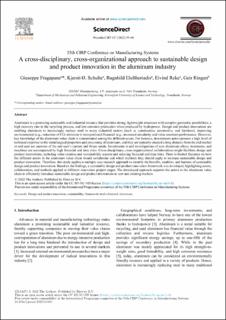| dc.description.abstract | Aluminum is a promising sustainable and industrial resource that provides strong, lightweight structures with complex geometric possibilities, a high recovery rate in the recycling process, and low-emission production when produced by hydropower. Design and product innovations are enabling aluminum to increasingly replace steel in many industrial sectors (such as construction, automotive, and furniture), improving environmental (e.g., reduction of CO2 emission in transport) and financial (e.g., increased circularity and value creation) performance. However, key knowledge of the aluminum value chain is concentrated among the different actors. For instance, downstream actors possess a high level of technical expertise in the metallurgical properties and processing of aluminum, and they are typically situated a long distance from the end market or end user are unaware of the end user’s current and future needs. Investments in and investigations of new aluminum alloys, treatments, and machines are accompanied by high financial and time risks. Cross-disciplinary, cross-organizational collaborations might facilitate design and product innovations, including value creation and sustainability aspects and reducing financial and time risks. There is limited literature on how the different actors in the aluminum value chain should collaborate and which methods they should apply to increase sustainable design and product innovation. Therefore, this study applies a multiple case research approach to identify the benefits, enablers, and barriers of sustainable design and product innovation. Based on the findings, a sustainable design and product innovation framework was developed, highlighting actors, collaboration, and methods applied at different innovation project stages. The introduced approach supports the actors in the aluminum value chain to efficiently introduce sustainable design and product innovations to new and existing markets. | en_US |

